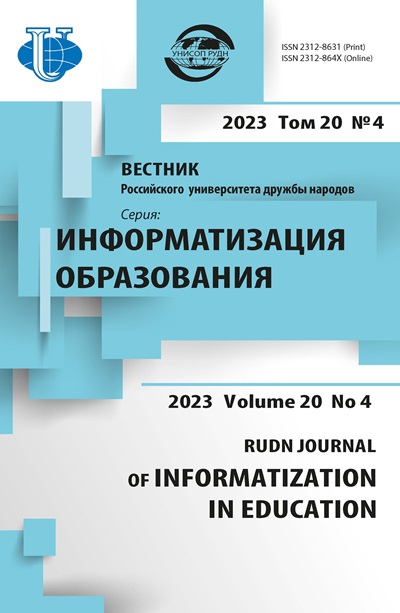Digital transformation of the university library in the context of information abundance
- Authors: Lotova E.Y.1
-
Affiliations:
- Peoples’ Friendship University of Russia (RUDN University)
- Issue: Vol 19, No 3 (2022)
- Pages: 249-264
- Section: DIGITAL EDUCATIONAL ENVIRONMENT
- URL: https://journals.rudn.ru/informatization-education/article/view/32260
- DOI: https://doi.org/10.22363/2312-8631-2022-19-3-249-264
Cite item
Full Text
Abstract
Problem and goal. In the context of digital transformation of education, the importance of digital library formation is justified, taking into account the training areas, research topics and other requests of all target groups of the educational institution. Active use by students and teachers of Internet sources raises the problem of popularization and disclosure of electronic collections, organization of problem-free access to valuable, reliable information from legitimate sources. Implementation of the practice of constant use of verified content by students, teachers, scientists has become the main task of the library. In this regard, the principles and methods used in the scientific library of the university for the collection and dissemination of information, organization of events, implementation of academic standards and new forms of work for the use of information resources in the educational process and research activities are studied. Methodology. As a generalization and systematization of the accumulated practical experience of working with electronic information, the stages of formation of a classical university digital library, methods of statistical analysis to evaluate the use of collections, forms of content promotion and work with target user groups are described. Results. The author analyzes the experience of the project on the formation and promotion of the university digital library, accumulates data on the effectiveness of content use, promotional mechanisms, achieved results for use in the work of libraries in the field of education. Proved the necessity of formation of university digital library using cluster approach - universal, specialized and profile resources, regarding peculiarities of promotion in different target groups of university, importance of analytical work on content use for optimization of subscriptions and elimination of information gaps, obligatory introduction of information culture and activation of digital educational resources use in the context of professional activity of the teacher. Conclusion. Using theoretical and practical data, statistical analysis and various aspects of both Russian and foreign experience of digital transformation of the university libraries in the conditions of information abundance, the stages of modification of the library collections, communication channels, and the results in a particular library were considered and analyzed.
Keywords
About the authors
Elena Yu. Lotova
Peoples’ Friendship University of Russia (RUDN University)
Author for correspondence.
Email: lotova-eyu@rudn.ru
ORCID iD: 0000-0002-8914-518X
Candidate of History Sciences, Director of Educational and Scientific Information Library Сentre (Scientific Library), Associate Professor at the Department of Information Technology in Continuing Education, Comparative Educational Policy Research and Training Institute
6 Miklukho-Maklaya St, Moscow, 117198, RussiaReferences
- Zubets VV, Ilyina IV. Estimation of reliability of network information. Russian Universities Reports. Mathematics. 2011;16(1):209–212. (In Russ.) Available from: https://cyberleninka.ru/article/n/otsenka-dostovernosti-setevoy-informatsii (accessed: 03.05.2022).
- Anuradha P. Digital transformation of academic libraries: opportunities and challenges. IP Indian Journal of Library Science and Information Technology. 2018;3(1):8–10. http://doi.org/10.18231/2456-9623.2018.0002
- Gerasimenko AY. Formation of a unified information space of a scientific library. Bibliosphere. 2019;(4):78–84. (In Russ.) http://doi.org/10.20913/1815-3186-2019-4-78-84
- Kozyreva A, Nazarenko U, Shovkoplias G, Beresnev A, Klevtsova E, Gusarova N. Integration of social media platforms and specialized web resources for the effective use of high-tech medical information. Proceedings of the 7th International Conference on Information and Communication Technologies for Ageing Well and e-Health (ICT4AWE 2021). 2021. p. 154–162. http://doi.org/10.5220/0010404501540162
- Al Dwairi KMO. Advanced specialized Jordanian libraries services by social media sites: Facebook. Methods. 2019; 9(3):72–81. http://doi.org/10.7176/IKM
- Gavrilova YN. Functions of the university library in the conditions of digitalization of education 2021. Sphere of Culture. 2021;(1):69–75. (In Russ.) http://10.48164/2713-301X_2021_3_69
- Golubeva EA, Smagina MV. Using the potential of electronic library systems in educational activities in higher education. Bulletin of Kemerovo State University of Culture and Arts. 2020;(50):211–218. (In Russ.). Available from: https://cyberleninka.ru/article/n/ispolzovanie-potentsiala-elektronnyh-bibliotechnyh-sistem-v-obrazovatelnoy-deyatelnosti-vuza (accessed: 06.02.2022).
- Lapo P. The role of information provision of science and education in the formation of the university digital space: the example of Nazarbayev University Library. Prospects of Higher Education Development. 2021;(10):93–113. Available from: https://cyberleninka.ru/article/n/rol-informatsionnogo-obespecheniya-nauki-i-obrazovaniya-v-formirovanii-tsifrovogo-prostranstva-universiteta-na-primere-biblioteki (accessed: 05.02.2022).
- Benedetti A, Boehme G, Caswell TR, Denlinger K, Li Y, McAllister AD, Quigley BD, Soehner CB, Wang M, Wesolek AJ. 2020 top trends in academic libraries. Library Faculty Presentations & Publications. 2020;80:270–278. Available from: https://digitalcommons.unf.edu/library_facpub/80 (accessed: 06.02.2022).
- Rowlands I, Nicholas D, Williams P, Huntington P, Fieldhouse M, Gunter B, Withey R, Jamali HR, Dobrowolski T, Tenopir C. The Google generation: the information behaviour of the researcher of the future. Aslib Proceedings. 2008;60(4):290–310. https://doi.org/10.1108/00012530810887953
- Nwachi C, Anozie C. Appraisal of the synchronous and asynchronous techniques of marketing library services in university libraries. Library Philosophy and Practice (e-journal). Available from: https://digitalcommons.unl.edu/cgi/viewcontent.cgi?article=6134&context=libphilprac (accessed: 06.02.2022).
- Lotova EY, Fomicheva SA. Efficient solutions for any information request! University Book Journal. 2019. p. 54–57. (In Russ.) Available from: http://www.unkniga.ru/biblioteki/vuzbiblio/9877-rezultativnye-resheniya-po-lyubomu-informatsionnomu-zaprosu.html (accessed: 06.02.2022).
- Lotova EY, Ledeneva YY. Engagement is more important than clicks: the use of Instagram by university libraries. University Book Journal. 2021. (In Russ.) Available from: http://www.unkniga.ru/biblioteki/bibdelo/12640-vovlechennost-vazhnee-klikov-ispolzovanie-insyagram-universitetskimi-bibliotekami.html (accessed: 06.02.2022).
- Lotova EY, Apakina LV. The new role of library as the creator and administrator of the educational portal of the university. Electronic Libraries Journal. 2017;20(6):426–434. (In Russ.) Available from: https://www.elibrary.ru/item.asp?id=32337952 (accessed: 06.02.2022).
- Bharti KL, Verma S. Use of emerging technologies in the university libraries: a study of review of literature. Library Philosophy and Practice (e-journal). Available from: https://digitalcommons.unl.edu/cgi/viewcontent.cgi?article=11579&context=libphilprac (accessed: 06.02.2022).
- Nneji KO. Digitization of academic library resources: a case study of Donal E.U. Ekong Library. Library Philosophy and Practice (e-journal). Available from: https://digitalcommons.unl.edu/cgi/viewcontent.cgi?article=5348&context=libphilprac (accessed: 06.02.2022).
- Kahle B. Transforming our libraries from analog to digital: a 2020 vision. EDUCAUSE Review. 2017;52(2). Available from: https://er.educause.edu/articles/2017/3/transforming-our-libraries-from-analog-to-digital-a-2020-vision (accessed: 06.02.2022).
















